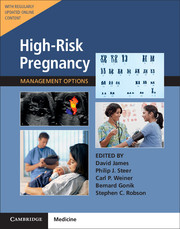Book contents
- Frontmatter
- Contents
- List of Contributors
- Preface
- Section 1 Prepregnancy Problems
- 1 Constitutional and Environmental Factors Leading to a High-Risk Pregnancy
- 2 Domestic Violence in Pregnancy
- 3 Female Genital Mutilation and Pregnancy
- 4 Genetics, Risks of Recurrence, and Genetic Counseling
- Section 2 Early Prenatal Problems
- Section 3 Late Prenatal – Fetal Problems
- Section 4 Problems Associated with Infection
- Section 5 Late Pregnancy – Maternal Problems
- Section 6 Late Prenatal – Obstetric Problems
- Section 7 Postnatal Problems
- Section 8 Normal Values
- Index
4 - Genetics, Risks of Recurrence, and Genetic Counseling
from Section 1 - Prepregnancy Problems
- Frontmatter
- Contents
- List of Contributors
- Preface
- Section 1 Prepregnancy Problems
- 1 Constitutional and Environmental Factors Leading to a High-Risk Pregnancy
- 2 Domestic Violence in Pregnancy
- 3 Female Genital Mutilation and Pregnancy
- 4 Genetics, Risks of Recurrence, and Genetic Counseling
- Section 2 Early Prenatal Problems
- Section 3 Late Prenatal – Fetal Problems
- Section 4 Problems Associated with Infection
- Section 5 Late Pregnancy – Maternal Problems
- Section 6 Late Prenatal – Obstetric Problems
- Section 7 Postnatal Problems
- Section 8 Normal Values
- Index
Summary
Introduction
An abnormal fetal phenotype can be caused by environmental factors, chromosomal anomalies, specific genes, or more complex genetic mechanisms. Because families with single-gene (Mendelian) disorders or parental chromosomal anomalies have the greatest chance of having children with genetic conditions, it is important to identify couples from such families before they undertake pregnancy
An assessment of a couple's risk can often be made by a combination of:
• Pedigree (family tree) analysis
• Precise clinical diagnosis
• Genetic testing, which is available for an increasing number of conditions
Particular pointers that might suggest that a couple is at increased risk of having a child with congenital anomalies include:
• A previous child affected with a single-gene disorder• A family history of a single-gene disorder• A parent with a chromosomal anomaly• Parental consanguinity• Advanced maternal age• Maternal illness or medication; maternal exposure to teratogens• Result of first- or second-trimester combined Screening
Determining the Genetic Basis of a Condition
To ensure that a family receives accurate genetic information, it is recommended that the following steps are undertaken:
• Record and examine the family tree to detect a pattern of inheritance.
• Refine and confirm the diagnosis by clinical examination and testing.
• Perform chromosome analysis or DNA testing, as appropriate.
• Assess the genetic risks to family members.
• Explain the genetic information to the family (genetic counseling).
• Discuss the available options.
• Support the family while they make decisions appropriate to their situation.
Identifying Families with an Increased Probability of a Genetic Condition
The couple may have realized that the family tree suggests a genetic condition and volunteer this information. In other cases, a high risk is appreciated only when a formal history is taken.
- Type
- Chapter
- Information
- High-Risk Pregnancy: Management OptionsFive-Year Institutional Subscription with Online Updates, pp. 54 - 84Publisher: Cambridge University PressFirst published in: 2017
- 1
- Cited by



